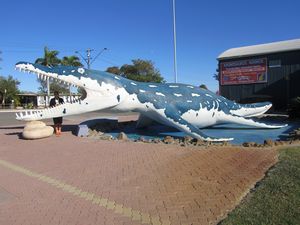Advertisement
Published: August 26th 2011

 Kronosaurus
Kronosaurus
Actual size of KronosaurusWell, we decided to do the three towns covered by the Dinosaur Trail. Until recently Australia was not well known for dinosaur fossils but it is now known that most of Australia supported dinosaurs and their fossils can be found where-ever the rock has eroded back to the relevant period rock. The first two towns, Richmond and Hughenden, are known for their marine fossils. The great inland sea which covered a lot of inland Australia retreated about 100 million years ago when sea levels fell the last time, so all fossils in this area are at least 100 million years old. We arrived in Richmond (our first stop on the trail) just as the museum opened and spent quite a while exploring the wonders of Australia's dinosaur discoveries. At Richmond is Kronosaurus Korner, a museum and fossil preparation laboratory. The range of fossils was simply amazing including Pliosaur (possibly the most complete and best preserved fossil in the world), Plesiosaur, several types of Ichthyosaurs, vaious fish, ammonites (think nautilus) and many others. However Richmond is famous for the Kronosaurus, an air breathing marine reptile over 12 metres long, with a skull twice as large as a T-Rex and twice as powerful.

 movie
movie
photo taken from a movieScientist claim a Kronosaurus would have a T-rex for breakfast. The model outside the museum is based on one of the fossils, so it was an awesome sight. Richmond also has a complete fossil of the Minmi, a land animal (an ankylosaur) that was washed into the sea where it died and was preserved. Really enjoyed the museum.
After the museum we went to one of the public fossicking quarries (the council clears the top layer of soil then exposes the sandstone/mudstone layer which holds the fossils) to try our luck finding a fossil. Not really knowing what exactly we were looking for we found a couple of pieces that we thought might be something and one small piece looked like a small jaw so we went back to the mueum and had the paleontologists look at it. The technician exclaimed "sweet" when he saw it and confirmed that it was indeed a jaw and that is was from a marine species, probably a fish (species unknown), from the cretaceous period, so at least 100 million years old. They said the best part of a fossil to find is the jaw with teeth, so Maree was quite excited by

 Pliosaur
Pliosaur
model and bones inside the museumthis stage. They put some resin into the bone (the bone is very fragile) for us to preserve it.
After Richmond we headed to Hughenden to the Flinders Discovery Centre which displays both local and overseas fossils. Hughenden has marine fossils but also younger land fossils such as the Muttabuttasaurus (named after the town of Muttaburra near where it was found - lucky it was not found at Humpty Doo, that would be an embarassing name). Mutta was a plant eater but was impressive nonetheless, with a length over 26 feet and weighing over 3 tons. A full size model of Mutta was displayed outside in the main street.
Then it was onto Winton which is the home of Waltzing Matilda (song) and also the Lark Quarry dinosaur trackway. The Winton area held Sauropds, large carnivorous dinosaurs, as well as many other smaller carnivorous and plant eating species (not all dinosaurs were large). The main interest was a visit to Lark Quarry where we would see the footprints from a dinosaur stampede that happened 95 million years ago. The tracks were clearly visible in the mud and the story behind what happened is amazing. As usual the photos

 Minmi
Minmi
A complete skeleton was found. It is common to give some fossils a name, in this case Minmicannot do it justice but will give an indication nonetheless. After extensive study of the trackway, scientists have worked out that a large tryannosauropus carnivour (a theropod weighing over 4 ton) stalked approximately 150 small dinosaurs (footprints of two types) on a small peninsular jutting out into a lake, as expected panic broke out, leaving over 3,300 footprints in the mud. The trackway is the only record of a dinosaur stampede in the world and has been extensively studied, in fact the trackway was the inspiration for the stampede in Jurrasic Park. The trackway also allows the scientists to study how dinosaurs ran, and again the trackway was used to get the proper running motion of T-Rex in one of the later Jurassic Park films. Scientists have determined that far from lumbering beast the carnivour could turn almost in it's own body length at speed as indicated by the footprints. Next day it was off to the Australian Age of Dinosaurs, a museum and fossil preparation laboratory, again fascinating. It really is amazing the number and range of dinosaurs that existed in Australia in the past.
Next, off to Longreach and the Stockmans Hall of Fame.
Advertisement
Tot: 0.124s; Tpl: 0.016s; cc: 7; qc: 49; dbt: 0.0866s; 1; m:domysql w:travelblog (10.17.0.13); sld: 1;
; mem: 1.1mb


























Michelle
non-member comment
: )
AWESOME!! That's all I can say!